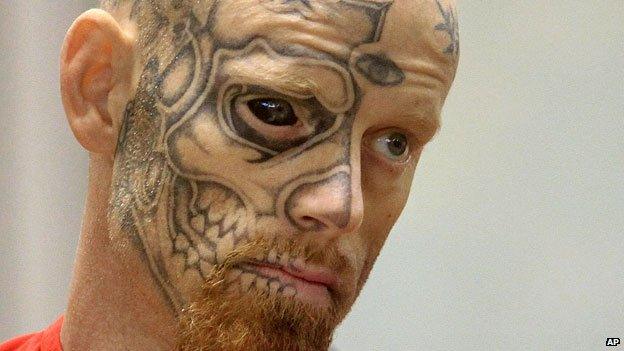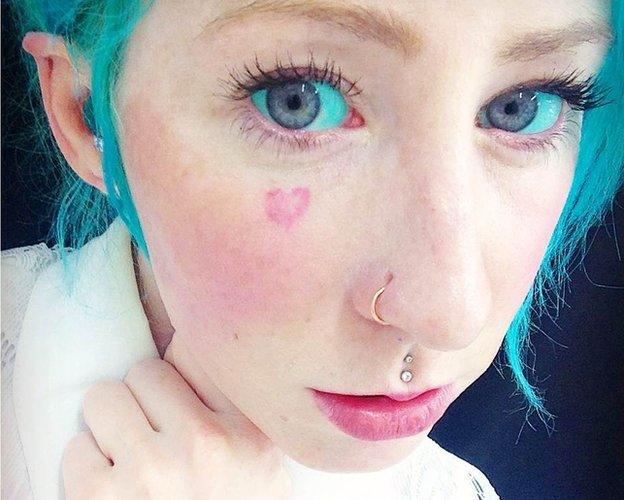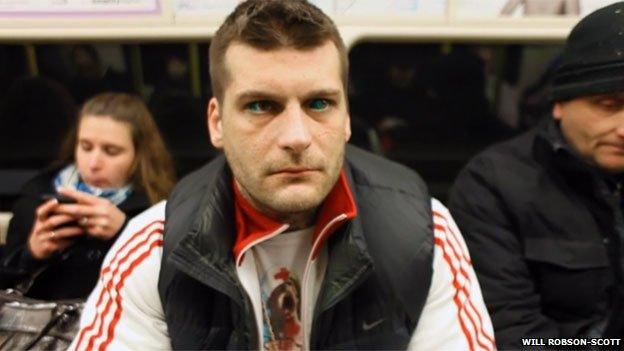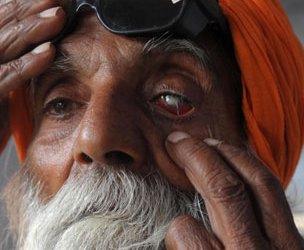Why would anyone want an eyeball tattoo?
- Published

The sentencing of a convicted criminal with an eyeball tattoo in an Alaskan court has drawn attention to an unusual form of facial decoration - one that is less than a decade old, but winning new converts all the time.
Jason Barnum, 39, who pleaded guilty to the attempted murder of a policeman, has ornate tattoos on his head and part of his face - teeth on his cheek, an eyeball in middle of his forehead. But even more dramatically, the white of his right eye has been tattooed jet black.
Arguing for the prosecution, Anchorage Police Department Chief Mark Mew urged the judge to take a look at Barnum's face which, he said, showed the convicted criminal had "decided a long time ago that his life was about being hostile to people".
But, in tattooing his eyeball, was Barnum really expressing hostility to the rest of society? And if our eyes really are the window to our soul what else might a tattooed eyeball say about its owner?
The man who first experimented with injecting ink into an eyeball is a US tattoo artist who goes by the name of Luna Cobra. Far from wanting to look evil, the original goal was to look like the blue-eyed characters from the cult science fiction film, Dune.
"There used to be a private body modification convention that happened every few years in Canada," Luna Cobra says.
"That year, an old friend had Photoshopped a picture of his eyes to look blue like in Dune. I told him, 'I think I can do that for real.'"
The next day, Luna Cobra took a syringe and practised on three brave volunteers.
"I'm aware of how insane that sounds, but I've been doing this type of thing for my whole life so I wasn't coming from nowhere with this," he says.
His technique, which he has modified over the years, involves injecting pigment directly into the eyeball so it rests under the eye's thin top layer, or conjunctiva.
A single small injection has enough ink to cover about a quarter of the eye. It takes several injections to completely cover the sclera, which is then coloured for life. He has done it for hundreds of people - in blue, green, red and black - from Singapore and Sydney to London and the US.
"If you want to amuse yourself by decorating your eyeball, why not do it?" he says. "I do a lot of things that look like tie-dye or 'cosmic space'. I think it brings a realm of fantasy into everyday life."

Kylie Garth says the response to her eyes has been uniformly positive
Looking a little out-of-this world is something that appealed to Kylie Garth, a body piercer who works in Luna Cobra's Sydney studio. Before deciding to change the colour of her eyeballs, Garth had experimented with a number of body modifications including face tattoos, piercings, elf-like pointed ears and a bifurcated tongue.
"It was mentally intense," she says of the several injections needed to colour her eyeballs a delicate blue-green, a colour she refers to as sea foam.
"It feels like somebody is poking at your eye, then it feels like strange pressure and then it feels you have a bit of sand in your eye, but there's no pain."
One customer who might disagree with this is a Polish rapper, Popek, who was filmed having his eyes tattooed green by Luna Cobra in London. A couple of days later he experienced a painful burning sensation in his eyes that prevented him sleeping.
Fortunately, it was temporary - he was later reported to be considering going back under the needle to darken the tattoos - but opticians warn about a risk of damage to the eyes, and even loss of vision.
Garth says the reaction to her eyes has been universally positive.
"It's thinking about getting a needle in your eye that makes people say, 'I can't believe you did that.' But I've never had anyone say my eyes look scary," she says.
The same can't be said of darker tattoos, however.
"I try to keep people away from it, especially if they have a dark iris," says Luna Cobra.
About one person a week contacts him to inquire about eyeball tattoos - and many want black.
"I tell them you're going to look frightening forever to the majority of people you encounter. You might find people have trouble connecting with you or looking at you because they can't follow your iris."
Luna Cobra says he urges young people to wait until they have a job before getting a black eyeball tattoo, because otherwise they may never get hired.
"I was living on the streets, and I tried to get a job, but of course my beautiful face didn't allow me to do that," Barnum said at his sentencing in Anchorage.
But whether or not Barnum intended to shock, many of Luna Cobra's clients are hoping to do just that. Some dismiss his warnings saying it would be "cool" to frighten people. Others say they don't care.

Popek the Polish rapper began to feel a burning sensation that kept him awake
Over the past few years, some US prison inmates, who already use tattoos to signal their crimes and gang affiliations, have attempted to colour their own eyeballs.
An episode of the US reality TV programme, Lockup, shows two inmates who try to tattoo their eyeballs blue and red using smuggled-in instruments.
"Everybody's got tattoos, everybody's got stretched ears [but] you never see anybody with the whites of their eyes tattooed," says prisoner David Boltjes, explaining why he took a huge risk to inject himself.
Luna Cobra says that what started as an experiment between friends, and fans of Dune, has run out of control. He's also heard that it's fashionable among Brazilian teenagers and in some Russian sub-cultures - and worries that people could be being harmed.
"It's shocking. We had no idea anyone else would do it. And now everyone's obsessed with it," he says.
"We often felt like we released a beast into the world and now all these people will be damaged," he says referring to the many ways the tattooing process can go wrong - from using the wrong ink and needle to injecting too much pigment or going too deep.
"It's a shame because I think it's something really beautiful, but it's taken an odd course."

A different effect can be achieved with coloured contact lenses
For its part, the American Optometric Association unequivocally condemns the practice, saying it puts the patient at risk of infection, inflammation and blindness.
"My advice is not to do it as there's not enough benefit to even warrant considering that risk of potential pain and loss of vision," says Jeffrey Walline, the chair-elect of the association's Contact Lens and Cornea Council.
Such is the concern that several US states have debated banning eyeball tattoos.
Garth, who says she is one of only a handful of women in the world with both eyeballs tattooed, says anyone considering the procedure needs to be absolutely sure they are making the right choice.
"It's not like you're going to get a little tattoo on your wrist," she says. "This is the most permanent body modification you can get, you can't take the ink out of your eye."
That may explain why eyeball tattooing is still rare art.
But, despite the risks, its popularity is growing. Before long it may not be that uncommon to come face to face with a stranger whose appearance is literally eye-popping.

Colouring the iris

The surgeon and philosopher Galen wrote about tinting the iris - the coloured part of the eye - in 150 AD
The procedure - cauterising the eye's surface and applying dye - masked clouding of the eye caused by cataracts, corneal scarring or leucoma
It was done for cosmetic reasons on patients who had already lost their sight
In the 19th Century the practice was revived, using a tattoo needle to apply ink - a refined version of the method is still used today

Subscribe to the BBC News Magazine's email newsletter to get articles sent to your inbox.